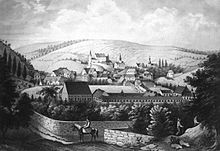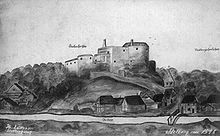St. Lucia (Stolberg)
St. Lucia is the name of the Catholic parish and church in the old town of Stolberg in Stolberg (Rhld.) In the Aachen region . The church is located east of Stolberg Castle and is the oldest church in the city and mother of other parishes. Its origins go back to the castle chapel .
history
The castle chapel was first mentioned in the 14th century. At that time it was under the patronage of the Holy Trinity . This is a typical castle chapel patronage. At that time it was still inside the old castle and went down with it in 1375.
The first graphic representation of the newer chapel from the 15th or 16th century can be found on the map of the Vichttal, which Egidius von Walschaple made in 1548. It shows a small chapel that hugs the castle rock. This was built outside the core castle, but still inside the outer castle within the outer ring. The pictured church facade with the windows is based on a hypothetical reconstruction of the original drawing damaged at this point.
The pastor of Eschweiler sued in 1550 because of the unauthorized appointment of a pastor in Stolberg by the lord of the castle Hieronymus von Efferen , who also had a cemetery built in 1554. Johann von Efferen even showed the Eschweiler clergyman the door and appointed a Protestant preacher in his place. He also allowed the Lutherans to use the castle chapel from 1592 to 1606. Until 1745 St. Lucia was a vicariate of the Eschweiler Church of St. Peter and Paul , since then it has been an independent parish. Capuchin priests worked here from 1737 to 1802. In 1802 the patronage changed completely to St. Lucia . In 1888, St. Mariä Himmelfahrt auf der Mühle was spun off as an independent parish, which in turn became the mother parish of St. Francis in Velau after the Second World War . Well-known pastors are Roland Ritzefeld (1840-1900), who expanded the church and built the Roland House named after him as the seat of the Catholic journeyman's association and the Bethlehem Hospital, and Maximilian Goffart , who equipped the church with a concert organ and from 1978 was auxiliary bishop in Aachen until his death in 1980 . Goffart's predecessor was the long-time pastor Boltersdorf, his successor Heribert Bahnschulte, who later became pastor in the Bethlehem Hospital. Today the parish is looked after by Pastor Funken, who is also the pastor of St. Mary's Assumption. In 1925 Pastor Schmitz became the first dean of the newly established Stolberg deanery . The parish handed over the sponsorship of the kindergarten to the city of Stolberg in 2006 because of the financial difficulties of the diocese .
Location, surroundings and building description
The church adjoins the castle to the east and has an east-facing orientation. It is strongly built into the slope: from Burgplatz or the Katzhecke in the north you descend a steep staircase, to the southern main portal a staircase leads up. Here is a limestone sculpture of the devil with a rooster that enters the visitor in a book. Two stairs lead up to the south transept parallel to the side aisle, but the doors of these stairs are no longer used today.
St. Lucia is a three-aisled basilica in the Neo-Romanesque style. The church was given its present form in the mid-19th century and the beginning of the 20th century, when the population growth as a result of industrialization made it necessary to expand the nave. The choir was expanded and the construction of the side aisles began under the direction of Pastor Ritzefeld. The construction of the church tower, which crowns the church building in the west, began in 1759, its two lower floors are still preserved in their original structure. When the damage caused by the 1756 earthquake was repaired, the nave was lengthened by 18 feet and an organ gallery was built. In 1851/52 a new choir and aisles were built according to plans by Theodor August Stein , the aisles were extended in 1859/60 and a new tower was built according to plans by Julius Kruse .
After the Second World War was the pinnacle of the church tower by onion dome replaced. In the west, across from the Torburg , on Lucia-Platz, there is also the rectory with the rectory's office and pastor's apartment, a white, listed building.
Churchyard
The churchyard was closed at the end of the 19th century in favor of the new cemetery on Bergstrasse. Today it is a green area and serves as a passage from the northern forecourt, Faches-Thumesnil-Platz, to Vogelsang. There is an old plague cross on it.
window
The style of the windows on the north side from 1891 can be assigned to historicism . They were made in the Johannishütte on Zweifallerstraße. The scenes from the Acts of the Apostles are part of the early work of the artist Christian Schneider from Stolberg, who had owned the renowned Cologne glass painting workshop Schneider & Schmolz since 1882 . The two lions in the arched window at the entrance to the Katzhecke are probably symbols of the Duchy of Jülich . The window of the sacrament chapel comes from the Aachen glass painter Maria Katzgrau (1912–1998). It was made by Oidtmann in Linnich in 1970 and shows colored ornaments.
organ
The organ was built in 1976 by the organ builder Heinz Wilbrand (Übach-Palenberg), whereby 8 stops were taken from the previous organ, which was built in 1938 by the organ building company Georg Stahlhuth & Co. The instrument has 42 registers on three manuals and a pedal . The Spieltrakturen are mechanically, the Registertrakturen electrically. The upper of the two originally existing galleries was demolished for the reconstruction of the organ.
|
|
|
|
|||||||||||||||||||||||||||||||||||||||||||||||||||||||||||||||||||||||||||||||||||||||||||||||||||||||||||||||||||||||||||||||||||||||||||||||||||||||
- Coupling : I / II, III / I, III / II, I / P, II / P, III / P
- Playing aids : 192-fold electronic typesetting system
Bells
In 1921 the Otto bell foundry from Hemelingen / Bremen cast three bronze bells for the Stolberg Lucia Church with the chimes g '- a' - h '. The two smaller bells survived the destruction of the bells in World War II. The g-bell was melted down. In its place came a bell from 1820 from an unknown founder. In 1962 Otto cast another bell for St. Lucia. So today a four-part bell can be heard from the tower with the strike note series: e '- g' - a '- h'. The diameters of the bells are: 1250 mm, 1100 mm, 900 mm, 800 mm. The bells weigh: 1400 kg, 660 kg, 480 kg, 350 kg.
Church treasure
The church treasures of St. Lucia include sacred objects, vestments, windows, books and sculptures. Two silver candlesticks were melted down to produce the baroque "Capuchin Chalice". A cross made in 1724 takes up oil and hosts when visiting the dying or sick. A neo-Gothic monstrance was stolen by intruders in 1919, one of whom was shot trying to escape.
Individual evidence
- ↑ From the castle chapel to the parish church: In: Altena, Christian: The building history of Stolberg Castle from the 12th to the 19th century. Master's thesis RWTH Aachen 2012. pp. 89–91.
- ^ Church window of St. Lucia , accessed on June 11, 2013
- ↑ More information about the organ of St. Lucia
- ^ Gerhard Reinhold: Otto bells. Family and company history of the Otto bell foundry dynasty . Self-published, Essen 2019, ISBN 978-3-00-063109-2 , p. 588, here in particular pp. 521, 559 .
- ↑ Gerhard Reinhold: Church bells - Christian world cultural heritage, illustrated using the example of the bell founder Otto, Hemelingen / Bremen . Nijmegen / NL 2019, p. 556, here in particular pp. 484, 513 , urn : nbn: nl: ui: 22-2066 / 204770 (dissertation at Radboud Universiteit Nijmegen).
literature
Coester, Ernst: St. Lucia in Stolberg. Cologne 2013. (= Rheinische Kunststätten Heft 545, published by the Rheinische Verein für Denkmalpflege und Landschaftsschutz)
Web link
Coordinates: 50 ° 46 ′ 1 ″ N , 6 ° 14 ′ 1 ″ E






